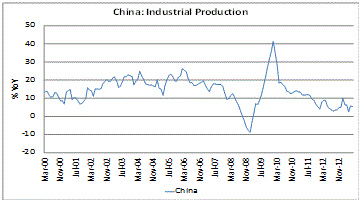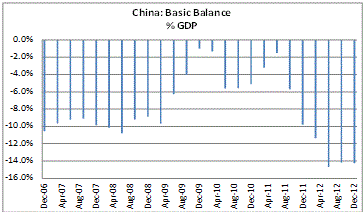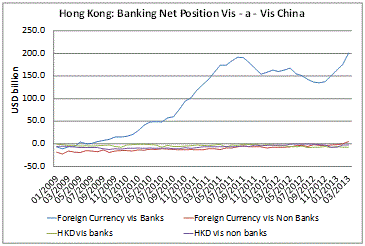Tyndall Monthly Commentary: China: External Discipline
“Whenever the Fed tightens, a body usually floats to the surface in the Emerging Markets” (A Quote from a prominent hedge fund manager in private conversation, June 2013)
Friday, August 2nd 2013, 8:30AM
by Andrew Hunt

The above quote was offered to us by a highly experienced US macro hedge fund manager and there is much in the statement that is true – the late-1980s Fed tightening cycle ultimately caused immense problems for the ASEAN economies in particular. Thereafter, 1994 was a calamitous year for Mexico; 1996-8 was a bad time for the emerging markets (EM) in general (and the Federal Reserve Board (FRB) had only hinted that it might tighten on that occasion); 2000 represented a very challenging time, as was 2004; and even more recently the FRB’s on/off Quantitative Easing Policies have generated volatility within the EM markets, amongst others.
Separately, when asked by a journalist recently how we would identify an EM, we responded (admittedly only semi-seriously) that it would be a country whose markets could be heavily manipulated/influenced by capital flows from foreigners and if there is any truth in our rather cynical categorisation, this would explain why EM equities seem to be much more correlated with global credit and capital market conditions than their own perceived economic growth rates.
Moreover, there is often a tendency for an EM that is in receipt of large capital inflows to become addicted to these flows. In the early 1990s, much of Asia received what were by the standards of their day unprecedented levels of capital inflows that first lifted the asset markets but which then also led many Asian companies and even individuals to change their models of behaviour (that is, by wasting capital and credit lines on grandiose projects and allowing operational inefficiencies to creep into their systems) and therefore to become addicted to this foreign capital as their own internal cashflow generation capabilities were compromised.
Visitors to Kuala Lumpur will no doubt still be impressed by the PETRONAS Towers and the other architecturally very imposing mid-1990s-era buildings but many, if not most, of these were built with the proceeds of foreign borrowing and by 1996, many Malaysian and, indeed, Asian companies had seemingly become overly dependent on continued foreign borrowing, not just to meet their CAPEX costs but also to meet their everyday working capital requirements. Unfortunately, when rumours that the US Federal reserve was going to tighten in 1997 emerged, these Asian borrowers found it relatively harder to source the credit to which they were addicted and the result was a sudden and very painful period of externally enforced austerity. The first body to float to the surface on this occasion was Thailand in early 1997, but many others soon followed over the next 18 months.
More recently, the bullish story for Chinese equities (which, admittedly, does not seem to have been working very well over recent years) has centred on the notion that Chinese wages are rising and thereby empowering a potential middle-class consumer. Unfortunately, there are three problems associated with this hypothesis.
Firstly, the Chinese or, indeed, Asian middle-class consumer seems not to have emerged, despite years of reported strong wage growth. There are many very rich Asian consumers holidaying in the Australasian region but the middle-class consumer has yet to emerge domestically, which suggests that something may be wrong with the underlying hypothesis.
We suspect that what is wrong is that wages have not been rising in line with productivity and national value added, but rather they have been rising as a result of a sharp increase in the domestic cost of living. Specifically, in China we find that land and food costs have been consistently inflating at a rapid pace over the last ten years (and by much more than the headline CPIs capture – despite the fact that there can be no more important costs to the average household than food and shelter) simply because domestic food output and the creation of affordable, rather than speculative, housing has lagged far behind the country’s rate of urbanisation. Indeed, we estimate that the growth in marketable food output has been, on average, less than half that of the growth rate of the urban population, with the result that food price inflation has been endemic.
Consequently, the second flaw in the popular “Chinese consumer story” is that the nominal wage growth has not equated to real wage growth as a result of the sharp rise in subsistence costs that has occurred.
The third and final problem for the China bulls has been that not only have nominal wages been rising in RMB terms, but the RMB has also been appreciating at a time in which world trade prices have been falling. Conservatively, we find that Chinese wage costs in USD terms have quadrupled over the last seven or eight years but, at the same time, we find that export prices have fallen by 10%, implying a significant margin and cashflow squeeze on exporting companies.

At the same time, though, the Chinese authorities have kept interest rates low and foreign borrowers have queued up to lend money to China, with the result that until very recently at least, China’s companies could not only borrow cheaply in order to cover their rising cost bases and declining profits, they could also build their own PETRONAS Tower-rivalling “cathedrals to cheap credit” (the Europeans built cathedrals at a similar point in their economic histories...) and at the same time build up massive levels of overcapacity in steel, solar panels, local government housing in the “wrong areas” and in a host of other sectors. In short, China has repeated the route taken by the rest of Asia in the mid 1990s and become addicted to cheap credit.
Although May and June were relatively bright months for the Chinese economy, the fact remains that underlying industrial production growth has slowed to around a 3-4% rate recently (this is our own index which is constructed from the “bottom up” sector data, rather than the rather arbitrarily constructed top-down-derived number that is usually quoted). To create even this mediocre growth (by Chinese historical standards), though, the authorities have, it seems, been obliged to create over USD1 trillion of new domestic credit over the last 4-5 months. On these figures alone, we can see just how destructive of capital and wasteful of credit China’s economy has become of late – hence the poor recent showing by its equity markets.
What we did not know until the FRB first hinted that it might taper its Quantitative Easing Policies a few weeks ago, though, was the true extent to which China’s companies and “wealth management companies” (the conceptual equivalent of the US’s shadow banks) had been borrowing abroad as well as domestically. After much searching through China’s own balance of payments data, the BIS global credit data and the accounts of many banks around the world, we can now reveal that China over the last six months was in receipt of perhaps half a trillion US dollars of credit flows. Some of these flows were simple carry trade flows by hedge funds and banks; Deutsche Bank has gone so far as to describe the CNY carry trade as the largest ever (beating the JPY and the AUD cycles of recent years). Elsewhere, some of these flows have occurred through nefarious channels in which they were often misreported as export receipts but, however these flows were achieved, over the last few quarters China has emerged as one of the world’s bigger borrowers in global capital markets. That this was not known until the FRB hinted at tightening is a rather concerning failure of the data.

Moreover, if we were to attempt to restate China’s much-vaunted balance of payments data without these now more-transparent credit inflows and look at the country’s underlying core balance of payments (what economists call the “basic balance”, a key indicator of the approaching Asian Financial Crisis), we find that China now has a very weak core external payments position.
Specifically, we believe that if the FRB were to tighten as promised (and we must at this point state that we doubt that they will do – this seems like a feint to us) and the capital and credit flows to China were to be interrupted on a more permanent basis than they were in June this year following Bernanke’s “fire drill”, then China would likely find itself facing a balance of payments deficit without these credit inflows. If the previous inflows were to become outflows as the funds were repatriated, though, China might well face a very significant balance of payments problem.
Certainly, the significance in this creation of an international payments deficit situation would be that it would remove – at a stroke – the Chinese authorities’ room for manoeuvre with regard to fiscal policy and interest rates. Any country wishing to defend its currency when facing a balance of payments deficit must either raise interest rates to attract more capital or tighten fiscal policy so as to reduce domestic demand and imports. India has already shown that this can happen to even the most hyped of BRICs, Brazil also seems to be erring in this direction and Southern Europe has shown this to be true even in smaller developed world markets.
If China were to find itself facing a drying up in the foreign credit flows on which it is now dependent, then local policy conditions would be obliged to tighten in what is already a quite weak economy. Indeed, we perhaps have already witnessed a “dry run” in this regard: the FRB’s hint at a possible tightening led to a sudden and dramatic spike in Chinese interbank rates and if the FRB were to move in a more determined fashion, then we could expect more of the same. Were this to happen, then we have little doubt that a recession would then unfold in China as investment spending declined sharply (whatever the official GDP numbers might say...).

A Chinese recession would of course be highly destabilising for global commodity producers, European and Japanese capital goods producers, and global trade trends in general. Indeed, a Chinese recession could prolong a global recession and bring with it another deflation scare within world markets.
Perhaps the biggest threat from a Chinese credit downturn, though, might be that of financial contagion. With Asian and Western banks now holding at least US$500 billion exposure to a currency that might depreciate and to an economy in which many of the borrowers are cashflow negative and therefore unable to repay their debts even if they wanted to or could be obliged to do in China’s legal system, there must be a high probability that some of these debts would be defaulted upon. At present, Hong Kong’s banking system, to name just one of the principal lenders, has lent more than the equivalent of a year’s worth of domestic GDP to China and we are far from certain that all of these loans are likely to be repaid if a drying up in credit forces China into a downturn and de-leveraging phase.
In the near term, signs of a modest rebound in Japanese, European and even some Asian production levels coupled with some soothing words from Mr Bernanke have made us quite optimistic with regard to risk asset prices in the near term but as the fourth quarter looms and talk of a FRB tightening re-emerges, we fear that China may find its access to global credit markets curtailed and history suggests that cashflow negative EM entities do not perform well under such circumstances. Investors should therefore pay close attention to China’s balance of payments position over the next few months since, were China to be forced into an externally imposed period of deleveraging, then the implications for global growth, trade prices and the global financial system could be quite severe.
Andrew Hunt
International Economist, London
Andrew Hunt International Economist London
| « Harbour Monthly Commentary: Bond Market Blues | Hamish Douglass Unplugged - Latest Video from Adviser Briefing - August 2012 » |
Special Offers
Comments from our readers
No comments yet
Sign In to add your comment
| Printable version | Email to a friend |









